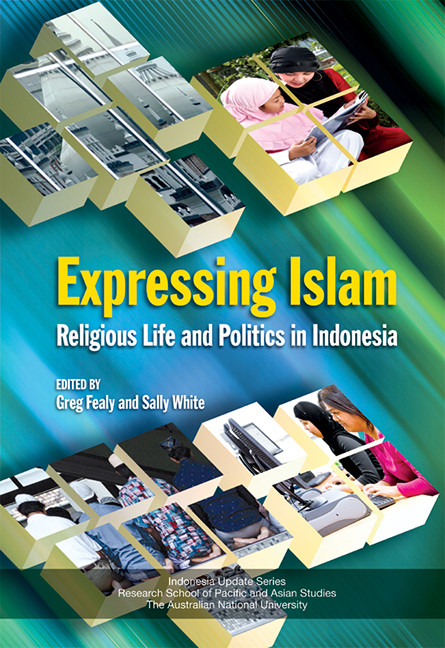Book contents
- Frontmatter
- Contents
- List of Figures and Tables
- List of Contributors
- Acknowledgments
- Glossary
- Map
- 1 Introduction
- PART I EXPRESSING PERSONAL PIETY
- 2 Consuming Islam: Commodified Religion and Aspirational Pietism in Contemporary Indonesia
- 3 Modulations of Active Piety: Professors and Televangelists as Promoters of Indonesian ‘Sufisme’
- 4 Throwing Money at the Holy Door: Commercial Aspects of Popular Pilgrimage in Java
- 5 ‘Spiritual Meal’ or Ongoing Project? The Dilemma of Dakwah Oratory
- 6 Marketing Morality: The Rise, Fall and Rebranding of Aa Gym
- PART II POLITICAL, SOCIAL AND LEGAL EXPRESSIONS OF ISLAM
- PART III THE ISLAMIC ECONOMY
- Index
- Indonesia Update Series
- Plate section
4 - Throwing Money at the Holy Door: Commercial Aspects of Popular Pilgrimage in Java
from PART I - EXPRESSING PERSONAL PIETY
Published online by Cambridge University Press: 21 October 2015
- Frontmatter
- Contents
- List of Figures and Tables
- List of Contributors
- Acknowledgments
- Glossary
- Map
- 1 Introduction
- PART I EXPRESSING PERSONAL PIETY
- 2 Consuming Islam: Commodified Religion and Aspirational Pietism in Contemporary Indonesia
- 3 Modulations of Active Piety: Professors and Televangelists as Promoters of Indonesian ‘Sufisme’
- 4 Throwing Money at the Holy Door: Commercial Aspects of Popular Pilgrimage in Java
- 5 ‘Spiritual Meal’ or Ongoing Project? The Dilemma of Dakwah Oratory
- 6 Marketing Morality: The Rise, Fall and Rebranding of Aa Gym
- PART II POLITICAL, SOCIAL AND LEGAL EXPRESSIONS OF ISLAM
- PART III THE ISLAMIC ECONOMY
- Index
- Indonesia Update Series
- Plate section
Summary
Some 100 kilometres west of Jakarta, not far from Old Banten, stands the tomb of Sheik Muhammad Sholeh, an early preacher of Islam in the region. The tomb is at the summit of Gunung Santri, a tree-clad hill overlooking the rapidly developing harbour town of Bojonegara. Gunung Santri is a modestly popular place of pilgrimage for Indonesian Muslims. As pilgrims approach the saint's tomb, and even inside the mausoleum itself, they have to negotiate a series of alms boxes. Slipping money into the slot on an alms box, or giving something to a tomb custodian (kuncen or juru kunci), brings merit to the pilgrim and an income to the local community. But many pilgrims, especially poor ones, face a problem. There are so many alms boxes, and so many less than subtle invitations to make a donation, that to relinquish a banknote at each alms box—even the smallest denomination banknote—is more than many can afford.
Fortunately there is a convenient solution. On the path that winds up the hill to the sheik's tomb, dozens of rickety stalls feed off the passing flow of visitors. Among them is a microscopic money-changing operation—an amoebic ‘bank’. Standing beside a rough wooden table two women offer cash-strapped pilgrims a simple but essential financial service. They replace banknotes with coins, taking a 20 per cent commission on each transaction. If a pilgrim lays a Rp 1,000 banknote on the table (the smallest denomination of Indonesia's banknotes, currently worth about ten US cents), he or she receives back a pile of eight Rp 100 coins. These go one by one into alms boxes or into the hands of tomb staff, buying merit for the pilgrim, saving them money, and generating a tiny but valuable income for the women of the ‘single-cell’ bank.
THE GROWING POPULARITY OF LOCAL PILGRIMAGE
Money and pilgrimage go together. In fact, it is the central argument of this chapter that not only is pilgrimage an increasingly significant component of the domestic travel economy in Java, but commercial transactions in the marketplace of pilgrimage are also metaphorical actions that parallel devotional ritual and illuminate the relationship between believer and God.
- Type
- Chapter
- Information
- Expressing IslamReligious Life and Politics in Indonesia, pp. 63 - 79Publisher: ISEAS–Yusof Ishak InstitutePrint publication year: 2008

